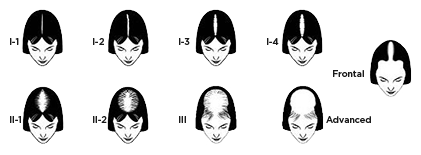Hair Loss in Women

Female hair loss is a common condition. Studies show that women make up 40% of hair loss sufferers.
While hair thinning can begin at any age, it often progresses more rapidly as women enter menopause. This is related to the loss of estrogen that occurs as women go through menopause. Estrogen normally has a protective effect against hair loss as it counteracts the negative effects that DHT has on the hair follicles.
The main physical difference between male and female hair loss is where the loss occurs. For men, loss and thinning begins at the temples and crown, whereas female hair loss occurs in the frontal and parietal areas. In most cases, women notice a change in their hair quality; it becomes thinner, less body, and more sparse. Often the part of the hair seems wider. It is rare for women to develop a fully bald crown.
The psychological and emotional damage caused by female hair loss can be different for women. Unfortunately, the medical community has not concentrated much energy on this subject. However, Dr Pinette recognizes the unique challenges that women face when losing their hair.
This all starts with a proper initial consultation. Each person’s medical history, hair loss history, and goals and expectations are reviewed. The scalp and hair is examined and in some cases further investigations (e.g., blood tests or scalp biopsy) might need to be done.
Dr Pinette will work together with you to create a management plan that is medically sound and meets your goals.
Of the treatments available for hair loss; any one or a combination of these treatments might be considered:
Topical treatments (Procrinix) or medication (e.g. minoxidil)
Oral medications (e.g., spironolactone)
Low level light therapy (e.g., Capillus Laser Cap, LaserCap LC, or in house lasers)
Platelet-rich plasma injections
Hair transplants
The Ludwig Scale
The Ludwig scale is used by most hair loss specialists to measure and analyze hair loss in Women. Exhibits I1-I4 show the central parting with thinning hair along the centre of the scalp. Figures II-1 and II-2 show a thinning across the top of the scalp while III and Advanced show excessive thinning and loss. Both the Advanced and Frontal exhibits are very uncommon among women.
